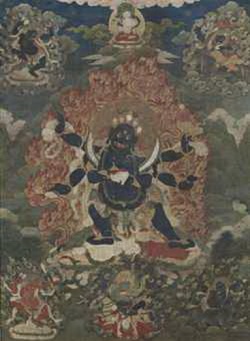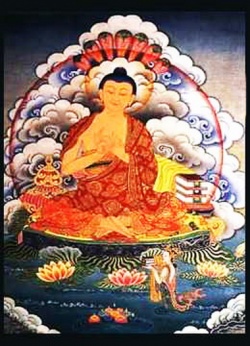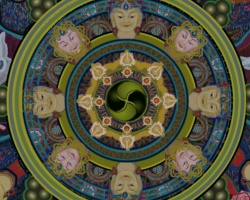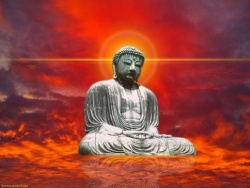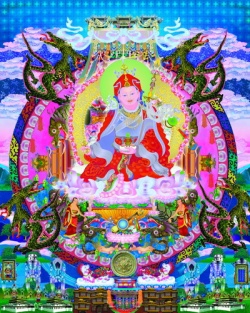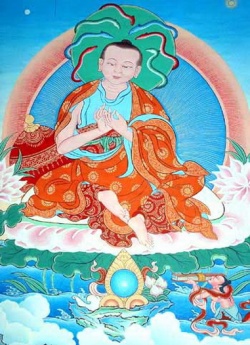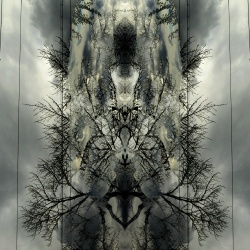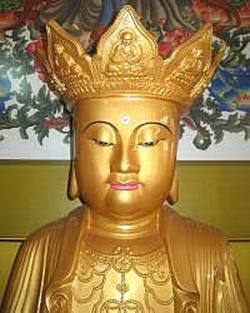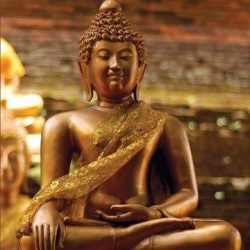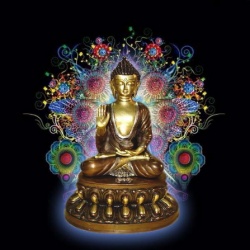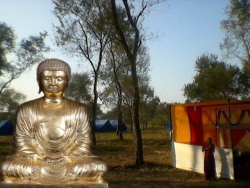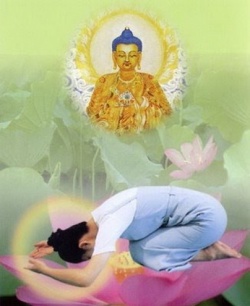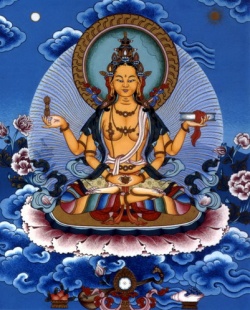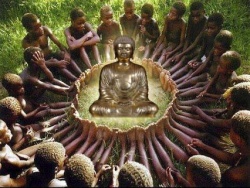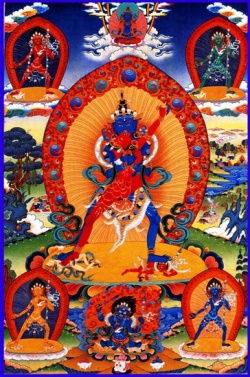Nirvāṇa
Nirvāṇa is the highest goal, the ultimate objective of human aspiration and the summum bonum of rational life and was declared by the Lord Buddha in his clarion voice to the suffering denizens of the three worlds (traidhātuka) as the panacea to the ills and sufferings of existence, to which all sentient beings from the amoeba to the highest god are subject without exception. And this ideal state, in which all suffering and pain are extinguished totally and irrevocably, was declared by the Master to be within the reach of all mortals, provided they elected to pass through the course of discipline which was styled the eightfold path (aṣṭāṅgikamārga). Whatever be the differences of views regarding the nature of Nirvāṇa, all schools of Buddhism have accepted it to be the most cardinal principle of their religion and philosophy. ‘
Nirvāṇam śāntam’ (nirvāṇa is the only calm) is the corner-stone on which Buddhist philosophy and religion stand and which gives the distinctive character that marks it out from other religious and philosophical disciplines. The persistent refusal of the Master to descant on the metaphysical implication of Nirvāṇa, which was rightly regarded by him as a matter of idle speculation without ethical and spiritual value, has, however, become a fruitful source of polemics among his followers and modern scholars too. The schools, into which later Buddhism became divided, hotly debated with one another on this all-important problem and were sharply divided in their opinions as to whether Nirvāṇa meant cessation of passions and sufferings only, or of existence altogether.
The emphatic denial of an individual soul, the ego-principle, by all sections of Buddhist thought has naturally given support to this negative [Page 238] conception and the result is that Buddhist Nirvāṇa is believed by all and sundry as a state of total annihilation of all existence, conscious or non-conscious. The criticisms of Brāhminical writers, notably Śaṅkarācārya and philosophers of the Nyāya - Vaiśeṣika school, have confirmed the belief in the negative character of Nirvāṇa and the consequence has been that Buddhism and particularly Buddhist Nirvāṇa have become a bugbear to scholars and laymen alike. The present writer has set himself the task of conducting a dispassionate enquiry into the various conceptions of Nirvāṇa that are found in the later schools of Buddhist philosophers and it is proposed to evaluate some of these theories on strictly philosophical grounds.
Let us examine the conception of Nirvāṇa as found in the Milinda Panha, a work of considerable antiquity and believed to represent the philosophical doctrines of the school of Elders (Sthavira-vāda). There, in answer to the queries of King Milinda, the Venerable Elder, Nāgasena, enumerates the characteristic features of Nirvāṇa. Although some of the qualities, which go to show that there is extinction of all pain and impurities, may be susceptible of a negative interpretation, there are some again, which unmistakably prove its positive character.
Nirvāṇa is said to allay all thirsts and cravings, even the craving after extinction. Nirvāṇa is said to be replete with the innumerable and various fine flowers of purity, of knowledge and of emancipation. Nirvāṇa like food is the support of life and puts an end to old age and death. As food increases the strength of all being, so does Nirvāṇa increase the powers of ṛddhi of all beings. As food is the source of beauty, so Nirvāṇa is the source of the beauty of holiness. Nirvāṇa like space is not born, does neither grow old nor dies, nor passes away, nor has it rebirth. It is unconquerable, is not liable to be purloined, is not attached to anything. It is the sphere in which arhats move; nothing can obstruct it; it is infinite. Like the wish-fulfilling tree, it satisfies all desires; it causes delight; it is full of lustre. As clarified butter is beautiful in colour, so is Nirvāṇa beautiful [Page 239] in righteousness. Like clarified butter again, it has the pleasant perfume of righteousness and has a pleasant taste.1
The catalogue of some of the qualities of Nirvāṇa in the foregoing paragraph unmistakably points to its being a positive existence, characterised as it is by permanence, blissfulness, freedom and purity. So Nirvāṇa, as conceived by the Venerable Kāgasena, does not evidently imply an extinction of all conscious life, but on the contrary points to a much too positive existence, nay, the highest life of purity and perfection and bliss. In the Viśuddhimagga, Buddhaghoṣa gives us a disquisition on Nirvāṇa which, if carefully analysed, will be found to be far from negativistic.
Nirvāṇa is characterised as the cessation of lust, of hatred and delusion (Saṃ Ni. Jambukhādaka Sūtta). Buddhaghoṣa warns us that mere cessation cannot be the nature of Nirvāṇa, as in that case the state of arhatship will have to be regarded as a state of cessation. ‘But why has it not been expounded in its specific character?’ asks the enquirer. ‘Because,’ the answer goes, ‘it is extremely subtle and the Master was not eager to dilate on this profound mystery. It is a state which can be envisaged only by the noble intuition of the saint.’ Again, ‘Nirvāṇa is without origination, as it has no antecedent cause.’ (Question) ‘But how can it be unoriginated, as it clearly emerges on the practice of the maggo (the disciplinary course enjoined as the means to attainment of Nirvāṇa)’? (Answer) ‘No, it is not produced by contemplation, it is only attained and realised by it. So it is without origin and because without origin, it is not subject to decay and death, and because it is not subject to origin, decay and death, it is eternal (nicca).
‘It is devoid of form and colour, because its nature is beyond that of coloured form. In reality it cannot be non-existent, as it is realisable by transcendental intuition, born of unremitting and unflagging perseverance and as it is attested by the words of the [Page 240] Omniscient Master, which run as follows:—
“There is, ye monks, an unborn (ajātam), un-become (abhutam), unmade (akalam), un-compounded (asaṅkhatam). If, ye monks, this unborn, un-become, unmade, un-compounded, were not, an escape from the born, become, made, compounded, would not be discernible. But because, ye, monks, there is an unborn, un-become, unmade, uncompounded, therefore an escape from the born, become, made, compounded, is discernible.”2
From what has gone before, we can legitimately infer that. Buddhaghoṣa. refuses to believe Nirvāṇa to be an absolute; ceasing of existence Nirvāṇa is ceasing of suffering, of lust, of hate and of delusion; but this does not argue that Nirvāṇa is absolute, extinction of existence also. Dr. Paul Dahlke has however taunted those who think Nirvāṇa as a metaphysical reality with the title of believers, as victims to conceptual thinking, which can never envisage the truth face to face. In support of his position he quotes,
“If, ye monks, only so much might permit of being attained of a self that would be permanent, lasting, eternal, unchangeable, eternally the same, then a possibility of a life of purity for the ending of all suffering would not be discernible” (San. Ni. III. 144).
The unconditioned _ (asankhalam) in th e Udāna text has been explained by Dr. Dahlke as non-conditioned, as the Ceasing of Lust, of Hate and of Delusion (San. Ni IV., p. l62). There are of course not a few passages in the Tripiṭaka literature, which can bear such negative interpretation that has been proposed by Dr. Dahlke. The Following quotation from the Ratana Suita, Verse 14, also lends support to the negative conception of Nirvāṇa and indeed this is one of the current interpretations among the present-day Buddhist monks of Ceylon and Burma, as Mr. Yamakami Sogen tells us.
‘Khiṇaṃ purāṇaṃ navaṃ natthi sambhavam,
Virattacittā āyatike bhavasmin,
[Page 241] Te khinabījā avirulhacchandā (aviru(d?)hacchandā?),
Nibbanti dhirā yathā’yaṃ padipo.”
“The old is destroyed, the new has not arisen. Those whose minds are disgusted with a future existence, the wise, who have destroyed their seeds (of existence), and whose desires do not grow, go out like this lamp.”3
This negative conception of Nirvāṇa is not a newfangled theory or a fiction of later scholasticism. It is older than the Laṅkāvatūra-sūtra, as was shown by the learned Japanese scholar, Yamakami Sogen. In the third chapter of the Laṅkāvatāra-sūtra we find a review of more than twenty different views of Nirvāṇa, which are all refuted on the score that Nirvāṇa is undefinable.
“The first,” says Prof. Stcherbatsky,
“evidently alludes to the opinion of the Hīnayānists and the last looks like the opinion of the Yogācāras.” (Conception of Nirvāṇa, p. 31, f.n. 2.)
Āryadeva is said to have written a commentary on this section, entitled “The Explanation of Nirvāṇa by heretical and Hīnayāna schools mentioned in the Laṅkāvatāra-sūtra This work has been translated by Prof. Gueseppe Tucci of the University of Rome. Prof. Stcherbatsky is inclined to believe this commentary to be a forgery by some incompetent Pandit (ibid).
The first view stated coincides with the negative interpretation and is as follows: —
“There are some philosophers, O Mahāmati, who maintain that by the suppression of the skandhas (five aggregates), dhātus (sic, 18 elements of existence), and āyatanas (12 bases), consequent on aversion to sense-objects arising from a constant study of the contrariety of things, the mind and mental affections in toto cease to function. And as a consequence, cognisance of the past, present and future objects ceases and all intellections are suspended as a matter of course owing to lack of nourishing [Page 242] material just as the light, seed and fire cease to function when all aliment thereto is withdrawn. This is their conception of Nirvāṇa; but, Nirvāṇa, O Mahāmati, is not attained by (such) a view of annihilation.”4
Again, in bis commentary on the first verse of Chapter XXV of the Mādhyamika-Kārikā, Candrakīrti quotes the views of a school of philosophers, who believed in two distinct types of Nirvāṇa, to wit, (1) Nirvāṇa with some residual substratum (sopadhiśeṣa), which an arhat attains in his life-time; and secondly, Nirvāṇa without any residuum (nirupadhiśeṣa). The first type of Nirvāṇa is attained when the entire catalogue of kleśas (defilements) beginning with nescience, desires and the like has been abandoned, but there remains behind a substratum (upadhi), which here stands for the five aggregates (pañcopādānaskandhāh), which are the foundation of ego-consciousness. Now in the first type of Nirvāṇa though the five aggregates persist, the illusion of an abiding personality has vanished for ever. This purified condition of the five aggregates has been compared to a village of robbers, when all the robbers have been executed. In the second kind, even the aggregates are annihilated and hence it is called Nirvāṇa without a residue. This final Nirvāṇa is comparable to a village, when not only its inhabitants have been totally annihilated, but the village too has been effaced out of existence.
So has it been said,
“With his body still at life,
(The saint) enjoys some feeling
But in Nirvāṇa consciousness is gone
Just as a light (when totally extinct)”
(Prof. Stcherbatsky.)
The final Nirvāṇa, without a residue, is thus attained when all the elements of conscious existence become extinct (tad evaṃ nirupadhiśeṣam nirvāṇam skandhānāṃ nirodhād labhyate, M. K. V., Ch. XXV).
I am inclined to believe that Śaṅkarācārya had some such school of thinkers in view whom he characterised as nihilists (vaināśikas). Prof. Stcherbatsky tells us that they were an early school of the Sautrāntikas who were full-fledged Sautrāntikas unlike the school of Dignāga which has been named by Prof. Stcherbatsky the school of Sautrāntika-Yogācāras. The older and more orthodox Sautrāntikas were perhaps an early offshoot of the Sthaviravāda school, who had their followers among the early Sautrāntikas and the present-day Buddhists of the Southern school. They are certainly not the Sarvāstivādins, whose direct successors were the Kāśmīra Vāibhāṣikas, mentioned by Vasubandhu. The Vaibhāṣika’s conception of Nirvāṇa was positivistic; it is absolutely a positive state of existence, from which passions and defilements of empirical, personalised life have been finally and irrevocably purged out and the chances of recrudescence of the miseries of mundane life have been removed beyond recall. It is a state of perfection par excellence. Although there is room for difference of opinion as to whether it is a spiritual living condition or an unspiritual, lifeless objective existence, there is absolutely no divergence about its positive character. This will become manifest in the following sections devoted to examination of the Vaibhāṣika and the Sautrāntika theories of Nirvāṇa.
II
The Conception of Nirvāṇa according to the Sarvāstivādins or the Vaibhāṣikas
[Page 244] The Sarvāstivādins maintain the existence of three eternal, incomposite categories (asaṃskṛta dharmas), which are immutable and as such remain uniform and unmodified through all time. The rest of the seventy-two categories or elements (dharmas) into which the objective and the subjective world of reality have been divided by the Sarvāstivādins, are composite (samskṛtas) and as such subject to constant mutation, though all reals are eternal and imperishable in their noumenal and substantial character (dharmasvabhāva). It is for this reason that the system is called Sarvāstivāda or “the philosophy of all existents.” Though all reals are subject to the law of causation (pratītyasamutpāda), the causal operation governs the aggregates and compounds, and not the ultimate elements or atoms.
The atoms however are never found in their free, uncompounded state, but are always combined in various proportions. These compounds are subject to constant flux and so change every moment anew, though substantially they remain uniform and unaffected. What change are their states or characteristics or attributes. But the incomposite, simple categories, to wit, ākāśa, pratisaṅkhyānirodha and apratisaṅkhyānirodha are eternal verities, absolutely uniform and unalterable. These two nirodhas and ākāśa are not negative entities, but are absolutely objective existences. The Sautrāntikas however regard them as purely negative ideas, mere conceptual forms, having no objective reference. In the Sautrāntika’s scheme of reality there is no place for an uncaused category and these three eternal verities of the Vaibhāṣikas have been regarded by the Sautrāntikas as mere intellectual fictions [Page 245] fondly objectified by an irrational imagination. These Sautrāntikas have very severely criticised the Vaibhāṣikas for their believing these uncaused fictions as existential categories, which is condemned as rank heresy.
In reply to the strictures of Uddyotakara in one place, Kamalaśīla observes, “your statement, that uncaused categories are twofold, viz., eternal and non-existent, only betray ignorance of the opponent’s (Buddhist’s) position, as the Buddhist rationalists (sic, Sautrāntikas) hold uncaused categories to be nonexistent illusions.
Verily has it been said by the Master—
“The Bodhisattva while reviewing the entire phenomenal world does not find a single phenomenon, which is exempt from the law of causation. As regards the Vaibhāṣikas who regard ākāśa and the like as objective existences, they are classed by us with the heretical schools and are not the true followers of the Buddha (Śākyaputrīyāḥ). So the advancement of their views in this connexion is not consonant with logical procedure.”5
Again in reply to the charge of Kumārila that eternal entities must be believed by the Buddhists to have occasional efficiency, as pratisaṅkhyānirodha and the like become objects of knowledge only after a human exertion, albeit they are eternal,—Śāntarakṣita and Kamalaśīla observe that this accusation of Kumārila is abortive so far as the Sautrāntikas are concerned. For according to them, these so-called eternal categories are mere intellectual fictions and as such can have no causal efficiency, which belongs to reality alone. And if the Vaibhāṣikas are intended, then, too, Kumārila’s charge carries no meaning, as the Vaibhāṣikas do not regard these nirodhas as nullities (abhāvas), as Kumārila imagines.
“Pratisaṅkhyānirodha,” Kamalaśīla continues,
“is nothing but dissociation (of the principle of consciousness) from the āsravas and kleśas (passions and impurities), and as this disjunction is effected by transcendental knowledge (pratisaṅkhyā) it is called nirodha dependent upon pratisaṅkhā (prajñā) or the [Page 246] highest knowledge of truth. This is a positive entity, as disjunction is a positive quality of the things that were in conjunction before, since it is logically an established proposition that the number of disjoined entities is exactly in ratio to that of the conjoined entities.
“As regards ‘apratisaṅkhyānirodha, it is not the opposite process as Kumārila thinks. It is altogether distinct from dissociation It is nothing but a circumstance, which makes the future emergence of likely effects absolutely impossible to materialise. This state cannot be realised by knowledge; it can be effected only by an absolute and irrevocable removal of the causes and conditions responsible for the production of the effects in question. And this is what is called nirodha not dependent on transcendental knowledge.”
“But Kumārila,” says Kamalaśīla,
“only betrays his woeful ignorance of the Buddhist position, which he has the temerity to criticise.”6
We shall see that these two forms of nirodhas have their respective parts to play in the evolution of Nirvāṇa.
And this pratisaṅkhyānirodha or dispersion of kleśas (passions and defilements) is the highest stage, the summum bonum of life and is synonymous with Nirvāṇa according to the Vaibhāṣikas.
Vasubandhu observes,
“The essential characteristic of it is everlastingness. Its description is beyond the power of the tongue of man. It can only be realised by the self-experience of a perfect man. Generally speaking it may be, for all practical purposes, designated as the highest good, eternally existing, which may be called also visaṃyoga or deliverance.”7
Both these nirodhas are necessarily involved in Nirvāṇa. The pratisaṅkhyānirodha by the removal of kleśas directly unfolds the state of Nirvāṇa and the apratisaṅkhyānirodha is also necessary to ensure the non-emergence of these kleśas by the perpetual removal of the causes and conditions of the same, pre-eminently [Page 247] of avidyā (nescience). So Śaṅkarācārya is absolutely in the right when he includes the cessation of nescience, etc., in the category of the first nirodha.8 But the truth of the matter is that according to the Vaibhāṣikas cessation of nescience and kleśas does not connote extinction, but mutual dissociation of the mind and passions from one another and this dissociation is called nirodha (obstruction or barrier) inasmuch as it serves as the unfailing barrier against any possible association in future.9
But Śaṅkarācārya from the very beginning has criticised the views of the Sautrāntikas and not of the Vaibhāṣikas, although he calls the view refuted as those of the Sarvāstivādins. Whether and how far again his criticisms of the Sautrāntika’s position are logically sound, that is entirely a different question and the value and force of such criticism is to be judged from the Sautrāntika standpoint. Whether Śaṅkarācārya erred in the matter of naming is not a very important question so far as the philosophical importance of his comments is concerned, if his criticism can be brought home against a particular school of Buddhistic thought. That he did not criticise the Vaibhāṣika doctrine is absolutely clear from the fact of his characterising the three eternal categories as absolute non-entities.10 Be that as it may, we have found that according to the Vaibhāṣikas Nirvāṇa is an everlasting existence, uncaused and unproductive by itself. It is an absolute and uniform reality, freed from imperfections and impurities of phenomenal life.11
We [Page 248] again take tbe liberty of quoting from the work of the learned Japanese scholar:
“One of tbe Buddhist elders called Sughoṣācārya (quoted in the Abhidharmamahāvibhāṣāśāstra) says: —
“Pratisaṅkhyānirodha is the dharma par excellence among all dharmas, the supreme goal among all goals, the highest of all things, the noblest of all reasons, the greatest of all achievements. And therefore is the title anuttaram or supreme. But what is the abode of this supreme dharma, Nirvāṇa or Pratisaṅkhyānirodha? Is it within or outside the universe?”
The answer is given—
“Pratisaṅkhyānirodha is neither quite the same as the skandhas nor quite different from them, but its nature is different from the sāsravadharmas.” (P. 116.)
Prof. Stcherbatsky in his illuminating work, The Conception of Buddhist Nirvāṇa, observes that this Nirvāṇa of the Vaibhāṣikas is a lifeless condition of the elements of existence.
“When all manifestations are stopped, all forces extinct, remains the lifeless residue. It is impersonal, eternal death, and it is a separate element, a reality, the reality of the elements in their lifeless condition. This reality is very similar to the reality of the Sāṅkhya’s undifferentiated matter (Prakṛti), it is eternal, absolute death.”12
Nirvāṇa, though a vastu, is not anything living or spiritual.
“The moral law conduces through a very long process of evolution the living world into a state of final quiescence, where there is no life, but something lifeless or inanimate. In this sense the Vaibhāṣika outlock resembles the the materialism of modern science.”13
Candrakīrti in his commentary on the Mādhyamika-kārikā refers to two schools of philosophers, of whom one regards the final state of Nirvāṇa as a positive existence and another thinks [Page 249] it to be an absolute annihilation, of the elements of existence. Chandrakīrti criticises these two theories with equal severity. Among the advocates of positivistic Nirvāṇa, he counts the followers of Jaimini, Kaṇāda, Kapila and lastly the Vaibhāṣikas.14 We know from Vasubandhu’s Abhidharmakoṣa that Nirvāṇa, which is represented by pratisaṅkhyānirodha in its positive aspect and apratisaṅkhyānirodha as its negative side, albeit a reality preventing the recurrence of the kleśas and their logical consequences, is an incomposite, unconditional (asamskṛta) category (dharma), and is eternal and is neither the product nor the cause of any other dharma. We have seen that Śāntarakṣita and Kamalaśīla are emphatic that these two nirodhas do not imply extinction of anything; only there is a mutual dissociation of the elements of existence without leaving any chance for a future combination and as this combination is the cause of the miseries of phenomenal existence, the Nirvāṇa becomes a state of absolute purity and perfection, without any tinge of pain and suffering.
Prof. Stcherbatsky also endorses the above view in the following words:
“At last the absolute stoppage of all the pure dharmas of the highest spiritual beings is reached, an eternal blank is substituted for them. This is Nirvāṇa, absolute annihilation of all the saṃskṛtadharmas, which is tantamount to the presence of asaṃskṛtadharmas.”15
And this conception of Nirvāṇa is in full accord with the metaphysical position of the Vaibhāṣikas, who maintain that all the seventy-two categories (dharmas) have a twofold nature,
“the one representing their everlasting nature (dharmasvabhāva) and the other their momentary manifestation (dharmalakṣaṇa).”
We know from Vasubandhu’s Abhidharmakosa and also from the Tattvasaṃgraha that these Vaibhāṣikas maintained the imperishable nature of all these dharmas in their noumenal state [Page 250] and the controversy only related to the nature and relation of their momentary manifestations, whether these manifestations in time connoted the change of attributes or of characteristics or of states of efficiency or only relativity.”16
Patañjali and Vyāsa in the Yogasūtra and the Bhāṣya respectively synthesised all these different theories and regarded these changes as virtually identical in character.17 The Sautrāntikas vehemently opposed this doctrine of the duality of nature, the division of entities into substantial and phenomenal aspects and they scented in it the reminiscence of Sāṅkhya and Jaina doctrines. However may that be, the imperishable and uniform existence of realities in their noumenal state is an accepted doctrine of the Vaibhāṣikas, and so the mind or intellect (manas) being one of the elements of existence must be set down as an eternal verity so far as its noumenal aspect is concerned. And as Nirvāṇa does not connote annihilation or extinction of being of any of the categories, and as it means that there is only an absolute dissociation and disjunction of the elements from one another, and consequently of all the manifestations of imperfect life, which were due to the association of these elements in the state of saṃsāra, the question relevantly arises as to what part the mind-category (manodhātu) plays in Nirvāṇa.
The mind exists, as extinction in the sense of absolute cessation of being, is denied by the Sarvāstivādins. But does consciousness exist? This is the crux of the problem and the determination of the Vaibhāṣika’s Nirvāṇa as spiritual or unspiritual hinges on the solution of this problem.
Prof. Stcherbatsky observes,
“It (Nirvāṇa) is, nevertheless, a kind of entity where there is no consciousness...... The theory is that consciousness cannot appear alone without its satellites, the phenomena of feeling, volition, etc.” (Ab. K., ii.)18
An interesting question is raised,
‘The last moment, of consciousness (of the arhat) [Page 251] before entering into unqualified Nirvāṇa will not then be a manodhātu, because it does not emerge into being? No, it exists in the form of manas, but there is no emergence of tainted consciousness which could link it to another birth and another phenomenal embodiment. The reason is that there is a total expulsion of the karman and passions, with their possible causes and conditions completely removed.’19
Now, what is this manodhātu? Can it be equated with consciousness? The manodhātu can be and has been equated with the several vijñānadhātus and this dhātu is nothing but the locus or receptacle and manodhātu being the substrate of different mental phenomena, as, e.g., saṃjñā (concepts), cetanā (will), vedanā (feeling), etc. has been regarded as a separate principle from these. And this is the reason why these mental phenomena have been classified into separate skandhas.20 It is proved that manas, is distinct from these mental phenomena, but it does not throw any light on the nature of manas, whether it is of the nature of consciousness, pure and simple, the variations being due to the presence of contents or it is like the soul of the Naiyāyika something unconscious and inanimate, the consciousness-states being the accidental products due to the co-operation of objective dharmas and the subjective sense-organs.
The manodhātu has been equated with manovijñānadhātu and the [Page 252] substrata of the five consciousnesses, beginning with visual consciousness (cakṣurvijñānadhātu) and ending in tactile consciousness (kāyavijñānadhātu). In discoursing on the graduated arrangement ot the skandhas in respect of their grossness or fineness, it is said that the aggregate of matter (scil.), sense-data (rūpa), is first enunciated, because it is the grossest of all, then feeling, then conception, then the mental faculties and tendencies (saṃskāra) and lastly vijñāna, because it is the finest of all, being “pure consciousness (without content).”21 If we are justified in taking Yaśomitra literally at his word, we can regard manas as of the nature of pure consciousness and if manas remains in its absolute purity in Nirvāṇa, as the Vaibhāṣikas suppose, then the Nirvāṇa of the Vaibhāṣika may be regarded as essentially spiritual in nature, since the existence of pure consciousness as in the Sāṅkhya conception of Kaivalya isolated existence of consciousness would not be barred out.
If, however, the principle of consciousness (manodhātu) is regarded as the substratum of consciousness, which is the plain sense of many texts, and this substratum be something distinct and different from consciousness itself, as it is indisputably declared to be distinct from feelings and conceptions and sensuous knowledge, being present as the locus or substrate of the same, we shall have to conclude with Prof. Stcherbatsky that Nirvāṇa according to the Sarvāstivāda school is a “materialistic kind of annihilation,” though the word ‘annihilation’ should not be taken literally in the sense of extinction of being, which the Vaibhāṣika emphatically denies and which the learned Professor has taken care to emphasise.22
Prof. La Vallée Poussin maintains that Pratisaṅkhyānirodha or Nirvāṇa is a dravya (substance) which the arhat enjoys in his [Page 253] life-time in the highest trance (saṃjjñāvedayitanirodha) and which remains when the arhat passes out of existence after death. The mind does not exist, nor any consciousness in the final Nirvāṇa. We must confess our inability to understand how this conception can be fitted into the metaphysical scheme of the Vaibhāṣikas, who like the Sāṅkhyas deny absolute extinction of any element of existence. Moreover the highest trance of saṃjñāvedayitanirodha on which Proof. Poussin bases his conception of Nirvāṇa, does not give us warrant to suppose that manodhātu becomes extinct in it. As the name indicates, there is only cessation of ideation and feeling. It is quite evident from Yaśomitra’s comment that the mind does not cease to exist, though the possibility of future thought-activity is brought to an end.
III
This Conception of Nirvāṇa according to the Sautrāntikas
[Page 254] The Sautrāntikas hold bondage (bandha) or phenomenal life (saṃsāra) to be an absolutely positive fact, being the outcome of causes and conditions, which are, in their turn, absolutely real. Nirvāṇa is the final aim and objective and is the only deliverance from the imperfections and limitations of phenomenal existence. In Nirvāṇa the pains and miseries of worldly life, the passions and defilements (kleśas) that taint the career of unfree souls, are totally and irrevocably extinguished and so Nirvāṇa is characterised as the summum bonum (śivam) and even as bliss being the negation of suffering. Whether Nirvāṇa is to be understood as denotative of a positive existence or a negative void will be determined in the course of our discourse and should not be anticipated at this stage.
The Sautrāntikas of course are absolutely emphatic in their denial of a personal individuality or soul-principle, permanent and everlasting, which is the accepted doctrine of all Buddhist schools of thought save and except perhaps the Vātsīputrīyas, who postulate the existence of a quasi-eternal spiritual substance over and above the discrete conscious states. We have fully elucidated the grounds of their denial of a personal self in the review of the Soul-theories of the various schools of philosophy and there it has been sufficiently proved that the life of consciousness is confined to a moment’s existence only. We have also established that bondage and emancipation do not contain any presupposition of an individual, unitive self as cementing the discrete moments of consciousness; and the continuity of consciousness is due to recurrence of consciousness units in close, unbroken succession, and does not imply the existence of any real continuum.
The chain or continuum is but an apparent, ideal continuum, being an illusion generated by the homogeneity of the moments of consciousness. Bondage only connotes the [Page 255] presence of nescience (avidyā) in the subjective centre with all its logical outcomes, birth, decay and death. These different stages of phenomenal life are all governed by the law of causality and so if there is avidyā at the bottom, decay and death will follow as inevitable consequences at the top. Bondage is, therefore, nothing but the presence of avidyā in the chain of consciousness from an undateable, beginningless time and contrariwise mokṣa or nirvāṇa is the absolute cessation of avidyā with all its paraphernalia. Śāntarakṣita in reply to the criticism of Kumārila declares that mokṣa (liberation) is nothing but the purified existence of absolute consciousness, freed from all taints of ignorance.23 According to Śāntarakṣita and Kamalaśila, therefore, bondage and liberation, saṃsāra and nirvāṇa, are positive entities, being the distinctive landmarks in the career of consciousness, the former being represented by consciousness in the grip of ignorance and defiling passions and the latter being free consciousness, purged and purified from the contamination of these masterful passions.24
These two representative authors, though they give their absolute allegiance to the subjective idealism as propounded by Dignāga and Dharmakīrti, have not hesitated to call themselves Sautrāntikas in more than one place and they have taken care to specify the doctrines of the Yogācāra school when they advanced them as the final truths. Their allegiance to the Sautrāntika school is therefore provisional, but it is unqualified and unhesitating so long as they hold to it. In fact the transition from the Sautrāntika to the Yogācāra position was an easy and natural passage. The reality of the external objective world was but a logical presupposition in the Sautrāntika’s [Page 256] scheme of metaphysics and so the Sautrāntika had to postulate the existence of two worlds side by side, an ideal and a real world.
The Yogācāra or Vijñānavāda as propounded by the school of Dignāga, who adopted the Sautrāntika position in logic and epistemology by way of compromise or concession, only explained away this logical presupposition and so the two worlds were reduced to one, the objective reality being unceremoniously shoved aside. So it is very difficult to decide at this distance of time whether the view of Nirvāṇa as posited in this connexion represents the orthodox Sautrāntika position or the position of the idealist, which is accepted as true philosophy by these thinkers. We have it on the authority of Guṇaratna that the Nirvāṇa of the Sautrāntikas consisted in the absolute cessation of the consciousness-continuum, the total extinction of the stream of consciousness, induced by an unremitting meditation on the principle of sōullessness.25
We have also indications of this theory from the Tattvasaṃgraha itself, which we propose to discuss at length in view of their utmost importance in the course of our present dissertation. Prof. Stcherbatsky tells us that the orthodox Sautrāntikas held that “Nirvāṇa was the absolute end of the manifestations, the end of passions and life without any positive counterpart.”26 But Śāntarakṣita and his worthy disciple tell us in plain and unmistakable language that Nirvāṇa is not discontinuation of consciousness, but its continuation save and except the passions and desires (kleśas). We propose to defer the discussion of this tangled problem for the time being.
Is avidyā a positive entity?
We have seen that bondage is nothing but consciousness in the grip of avidyā, and mokṣa or nirvāṇa is but the emancipation of consciousness from the hypnotic spell of this avidyā. Now, [Page 257] what is the nature of this avidyā? According to the monistic Vedāntists avidyā is an indescribable stuff, neither absolutely real nor absolutely unreal, but something different from both of them. It cannot be supposed to have a distinct existence outside consciousness, as it works in and through consciousness alone; nor can it be non-distinct from consciousness, as it is destroyed by knowledge, and knowledge is consciousness in essence. So it is an unclassifiable, nondescript something. It is neither an airy nothing nor a real something. It is not an entity as it disappears totally and irrevocably, but it cannot be regarded as an absolute nonentity like the rabbit’s horn or sky-flower, as it has causal efficiency. The nature and functional activity of avidyā is illustrated by examples of common illusion like the illusion of a snake on a rope.
The snake is not a real snake, but so long as the subsequent knowledge sublating the idea of snake does not emerge, it is as real as anything. But when the rope is known to be a rope and not a snake as falsely perceived before, what happens to this snake? Well, it vanishes as an airy nothing. The snake is an unreal fiction, but though unreal, it is perceived like a reality and this demarcates it from such fictions as a sky-flower or a barren woman’s son, which are never perceived even in illusion. Butin its essential character the rope-snake is as hollow and unsubstantial as these fictions of the imagination. It is a product of avidyā, an illusion born of another avidyā, which, though checkmated and chastised in one case or another, reappears in other forms and under other shapes. Avidyā possesses an infinite resourcefulness and is neither baffled nor abashed. The only thing that it cannot stand is the light of true knowledge, which kills it outright, root and branch, with all its resources and magical powers.
Kamalaśīla, however, in common with all realists, refuses to subscribe to such an illusive category, which is neither being nor non-being. He asks, ‘Is avidyā identical with Brahman or distinct from it? If it is non-distinct from it, Brahman and avidyā will be identical and the consequence will be the [Page 258] impossibility of emancipation (mokṣa). Because, tbe Absolute being eternai and uniform and avidyā being an integral part of its essence, the latter will be indissoluble and emancipation as the result of cessation of avidyā will be a meaningless jargon. If on the other hand avidyā is distinct from Brahman, it will have no influence on the latter. And even if a relation be conceded, it will be of no avail, as Brahman being an eternal, uniform principle will not be liable to any supplementation or detraction from that quarter. So the relation of avidyā and the Absolute being out of the question, there would be no saṃsāra (birth and death), for whose cessation emancipation would be sought after.
Moreover, it is positively illogical to say that avidyā is something which is neither distinct nor non-distinct from the Absolute. A reality must be capable of being defined either as identical or as non-identical with another. There can be no half-way house between two contradictories, as this would constitute a flagrant breach of the Law of Contradiction and the Law of Excluded Middle. Nor can avidyā be conceived to be an unreal nonentity, since that would contradict experience. An unreal fiction cannot have any causal efficiency, and causal efficiency alone is the line of demarcation between reality and unreality. If, in spite of this causal efficiency, the Vedāntist insists on calling it an unreality, we Buddhists, shall have no quarrel, with him, as the dispute is reduced to a question of nomenclature.
The Buddhist Conception of Avidyā.
Avidyā is, in the judgment of the Buddhist, a positive entity and not a fictitious category as conceived by the Vedāntist It is the inherent tendencies of the mind, the subconscious impulses and drives (vāsanās), which make the mind cling to false ideas and notions. And these tendencies and subconscious drives have a causal energy and as vehicles of energy they are an essential part and parcel of consciousness. So in conformity [Page 259] with the law of causal. operation the preceding moments of consciousness as informed with avidyā produce by their inherent causal energy the succeeding moments of consciousness instinct with false tendencies and impressions, it being an established proposition that the effect inherits the nature of the cause.
It is nothing strange, therefore, that the mind should conjure up false ideas as those of an abiding ego-principle, God and the like. But this avidyā can be rendered weaker and weaker in each succeeding moment by a graduated course of meditation (yogābhyāsa) until the last vestige of the bias of ignorance and superstition is totally removed and a stream of consciousness is let loose, absolutely purified and cleansed of all taints of passions and ignorance. And the emergence of such a pure stream of consciousness is but emancipation (apavarga), the highest good, the ultimate goal of aspiring humanity, in which there is no suffering, no limitation, no imperfection, as the sole cause of it has been destroyed once for all without leaving any chance for its recrudescence even at a distant date.27
Nirvāṇa, we have seen, is primarily and principally a cessation of the kleśas, headed by ignorance and consequential impurities. Now, what is the process, the modus operandi of this cessation of the formative principles of phenomenal life, in other words, of the cycle of births and deaths? What is the antidote to these ills of life, (sic) of ignorance and passions, which are the mainspring of the perverse will to live? Śāntarakṣita assures us that these kleśas (passions and ignorance), these veils of truth, totally vanish as soon as the truth of non-egoity is realised just as darkness vanishes in the presence of strong light.28
Now, there are two kinds of veils or positive hindrances to moral and spiritual perfection, to wit,
the veil of ignorance and passions (kleśāvaraṇa), which impedes the realisation of purity and truth;
[Page 260] and the veil covering the ontological reality (jñeyāvaraṇa), which again is twofold, viz., one which hinders the thoroughgoing discerning knowledge of reality as to what is worthy of acceptance and what is worthy of rejection and secondly, what induces the incapacity for exposition of the realised truth to others.
The first kind of veil (sic of passions) can be got rid of by a realisation of the illusory character of the ego-principle (nairātmyadarśana) and the other can be overcome by an unremitting and zealous meditation on this non-egoity carried on for a prolonged period of time. But why should this realisation of non-egoity have such extraordinary efficiency in the matter of removal of passions and imperfections? Is it a mere dogma or a well-reasoned psychological truth? For an adequate explanation of this proposition it is necessary to enter into the psychological origin of these passions and cravings for individualised existence, which are held responsible for the miseries of metempsychosis.
Now, these passions of love or hatred and the like have certainly their foundation in the perverted belief in the existence of a personal soul, which, however, has been proved to be a baseless illusion. These passions of surety have nothing to do with external objects, as these feelings do not arise in spite of the external world when the belief in a personalised existence is lacking and on the other hand they crop up with a vengeance though the external objects of love or hatred may be absent, when the belief in the masterful ego is in possession of the field. So by the joint method of Agreement and Difference these passions must be causally affiliated to the unfounded belief in the existence of a personal self.29 It is a matter of logical deduction that in the absence of egocentric bias self-love cannot [Page 261] arise and attachment to external objects too cannot originate if they were not affiliated to the self as conducive to self-interest and self-gratification. Likewise hatred too will have no raison d’etre, as a man comes to resent things or persons that are supposed to thwart his interests, but when a man has no reason to be interested in anything, obstruction of interests becomes unmeaning.
The same fate awaits other passions, because they have their roots remotely or immediately in self-love. Thus, ego-consciousness firmly established by repeated illusions from beginningless time extends to external objects, which come to be prized as promoting self-gratification and any obstruction to these objects naturally excites his resentment and hatred. And the whole catalogue of passions comes into being, and as time wears on, they acquire a fresh lease of life and a fresh accession of strength by the sheer right of prescription and the result is all-round confusion and misery.
Now, these evils are not natural growths or attributes of living creatures; they are exotic growths and excrescences fostered by self-love and so are bound to vanish if egoity is demolished. And this egoity is an ungrounded illusion. The subjectivity of an individual has been shown by us to have no foundation outside the concatenation of momentary psychical units, which are individualized into an abiding self by a false superstition.
It may be urged,
‘let there be no soul or real individuality, but consciousness is a fact and these passions may be natural attendants of this consciousness, as they live and move and have their being in it. And so they may be ineradicable like consciousness itself.’
But this contention is not based on a logical assessment, of the character of these passions. Well, what is the normal function of consciousness? It is assuredly nothing but to apprehend reality as it is, otherwise the relation of subject and object, knower and known (viṣayaviṣayibhāva) cannot be established. And if our intellectual life is not to be condemned as bankrupt, it must be admitted that the normal function of consciousness is to apprehend [Page 262] the reality in its true nature and the true nature of things, both subjective and objective, has been proved to be in a state of perpetual flux without any underlying substratum either in the shape of an abiding self or a permanents substance. So consciousness must be supposed to take stock of the principle of non-egoity and non-egoity alone in its normal healthy state.
The fact that consciousness gives us the report of an ego-principle must be set down to adventitious defects, which are abnormal accidents like the illusory perception of a snake on the rope.30 This gives the key to the secret as to why ego-idea goes to the wall in its contest with the idea of non-egoity, though antagonism is the common factor. The reason is that ego-consciousness is a false superstition fostered by abnormal conditions, which are, happily, aventitious phenomena and non-egoity, on the other hand, is based upon truth and so is natural to our thinking principle. It is for this reason that non-egoity invariably triumphs over egoism, because truth is constitutionally stronger than falsehood. With regard to the idealists even, who do not believe in external reality and consequently deny that the normal function of consciousness is to apprehend external reality in its true nature, our explanation also stands.
Though these idealists deny external reality and believe the contents of knowledge to be manifestations of consciousness, still they have to acknowledge that consciousness is self-regarding (sic self-conscious), otherwise there will be no discrimination and consequently no knowledge. The knowledge of ‘blue’ and the knowledge of ‘red,’ though equally manifestations of consciousness, are certainly distinct and distinguishable [Page 263] and they can be distinguished, if consciousness can know itself in its manifestations. Consciousness has, therefore, to be admitted as self-regarding (sic) as self-intuitive and if knowledge per se is not to be condemned as something essentially rotten, it must be accepted that the normal function of consciousness is to know non-egoity in the form of pure consciousness bereft of subject-object distinctions, which is the ultimate reality.
So ego-consciousness being an unfounded illusion, the whole catalogue of passions, major and minor alike, must be supposed to be exotic overgrowths and not natural to consciousness. Their extinction is, therefore, inevitable only if the proper antidote in the shape of realisation of non-egoity is applied. That these passions do actually grow and have their being in consciousness is no argument that they are natural and inevitable to consciousness. Mere appearance in some substratum does not argue that it is either natural or inevitable to it. The snake also appears on the rope but it is not believed to be natural. If subsequent disappearance is the reason of its falsity, the same logic applies to these passions, which are experienced to disappear when non-egoity is contemplated.31
It may be urged that the antagonism of egoity and non-egoity is not an established truth and is only a dogmatic assumption. Because, it is a matter of experience that even philosophers who are convinced of the truth of non-egoity are as much subject to fits of love and anger as ordinary mortals are and this points to the other way—that conviction of non-egoism is not hostile to the existence or active functioning of these passions. But this objection is only a specious argument. The conviction of non-egoity, which is claimed by us, Buddhists, to be antagonistic to egoism and its derivative passions, admits of varying degrees and grades of perfection. Thus, (1) one comes to believe in the truth of non-egoity from the [Page 264] teaching of an expert.
The belief is inspired by the teacher’s lecture and the truth is accepted more on trust than on conviction (śrutamayajñāna). (2) The second stage is reached when a person convinces himself of the truth by logical arguments and this is called intellectual conviction (cintāmaya). (3) But when by incessant, energetic meditation on the truth intellectually realised, the mind acquires requisite strength and clarity of vision and ultimately envisages the truth face to face, in all its fullness and richness, all doubts are dissolved and the man is said to have realised the truth of non-egoity. This is intuition born of contemplation (bhāvanāmayadarśana). And it is this transcendental intuition of non-egoity that is regarded by us as the antidote to egoity and its satellites, passions of love and hatred and the like. So there is no logical flaw in our position.32
So it is only when the profound truth of non-egoity is fully realised by reason of a course of unmitigated and unremitting mediation, the ego-consciousness with all its satellites vanishes into airy nothing without leaving behind any trace or vestige. The ego-consciousness, though an illusion in essence, has however been fostered by a habit of thought, which has no beginning in time, and as a consequence has become almost an integral part of the thought-principle by sheer length of time. It is not at all strange, therefore, that it cannot be uprooted all on a sudden by the mere lecture of a professor. These passions can be made weaker and weaker by a gradual strengthening and fostering of the opposite modes of thought and thus by a long-standing cultivation of spiritual regeneration they can be destroyed root and branch.
The neophyte in spiritual discipline has reason to be encouraged by the fact that these passions, exotic growths that they are, cannot raise their head when the mind philosophises on their unreality and worthlessness.33 So [Page 265] there is not the slightest room for doubt or hesitation that realisation of non-egoity will remove these evils of life in toto and ultimately land us in the realm of Nirvāṇa, the summum bonum of life, where there is not the slightest tinge of suffering and impurity.34
The realisation of non-egoity, we have seen, is the only way to Nirvāṇa. In fact, non-egoity is one of the fundamental truths, nay, the central plank of Buddhist religion and philosophy. But the crux of the problem lies not so much in the way to Nirvāṇa, the theoretical and practical discipline enjoined as preparation for reaching the goal, as it is in the conception of Nirvāṇa itself. To state the problem in plain words: Is the Nirvāṇa of the Sautrāntika a positive state or a negative void? Is there consciousness in Nirvāṇa or is it a pure voidity with no consciousness in it? We have already quoted Kamalalśīla and Śāntarakṣita speaking of Nirvāṇa as a pure stream of consciousness with all taint of avidyā purged out.
In another place Śāntarakṣita states,
“This doctrine, that there is no self, will terrify the ignorant heretic. But it was preached to his disciples by the Lord with a view to their ultimate good.”
Kamalaśīla in this connexion quotes an ancient verse in support of the text which is as follows:
“The ego does not exist, nor will it ever come to exist; likewise nothing pertaining to the self exists or will ever come into existence. This (idea) is a veritable terror to the soft intellect, but it dissolves the fears of the wise.”35
But these texts are not explicit. It is clear that there is annihilation of individualized consciousness in Nirvāṇa, and it is quite possible that impersonal consciousness may remain [Page 266] and this has been plainly stated in more than one place.36 It is also stated that contemplation of non-egoity destroys avidyā and not consciousness per se. These passages only indicate that ego-consciousness is a delusion and there is no ego-principle as is supposed in the heretical schools. They only prove that the extinction of ego-consciousness is the ultimate objective and this is realised in Nirvāṇa. But there is no indication that extinction of consciousness as such is the desideratum.
In another place, Śāntarakṣita tells us that
“true knowledge is knowledge of pure consciousness alone, completely disentangled from the accidental impurities. It has been proved that consciousness per se is devoid of subject-object relations and is free from two sorts of delusions and this is the truth that has been promulgated by the Enlightened ones.”37
All this proves that pure, impersonal consciousness in the abstract is the ultimate reality and Nirvāṇa is nothing but the realisation of this truth alone.
But does the above conception of Nirvāṇa represent the Sautrāntika point of view? A doubt is roused when Kamalaśīla tells us that this doctrine of impersonal consciousness has been established in the chapter on ‘Examination of external reality,’ where the position of Buddhist idealism (vijñānavāda) has been expounded. If this explanation of Kamalaśīla be supposed to imply that the doctrine in question is the property of Buddhist idealists, we have to revise our estimate of the Sautrāntika conception of Nirvāṇa. Śāntarakṣita and Kamalaśīla are seen to admit the possibility of extinction of consciousness in Nirvāṇa as an accepted doctrine of the Śrāvakayāna and this perhaps is the orthodox Sautrāntika conception.
Guṇaratna expressly [Page 267] tells us that in the Sautrāntika’s conception Nirvāṇa consists in the annihilation of the stream of consciousness. The Brāhminical writers have attacked this doctrine of annihilation in severe terras and Śaṅkarācārya, who criticises the Sautrāntika position in his Ś ārīrakabhāṣya, has nicknamed these Buddhists as nihilists (vaināśikas). That a class of Buddhist philosophers, presumably the Sautrāntikas, held the view that in Nirvāṇa the con-sciousness-continuum becomes totally defunct owing to lack of passions and desires, is evidenced from the Tattvasaṅgraha and the Pañjikā also. And this fact was taken advantage of by the materialist when he claimed total extinction of consciousness after physical death on the analogy of the final consciousness of the Saint.38 Śāntarakṣita does not challenge the authenticity of the example cited by the materialist.
He only makes a reservation in the case of the Bodhisattva who does not enter into final Nirvāṇa by surrendering the conscious life but on the contrary sedulously preserves his subjectivity to render succour to the suffering world. But this view was held by the Mahāyānic philosophers and was not accepted by the Śrāvakas. Śāntarakṣita admits the possibility of extinction of consciousness in the case of Śrāvakas, who have no such incentive to maintain their individuality as the Bodhisattva has. Śāntarakṣita, we are tempted to believe, only seeks to reach a compromise with the Mahāyānists and to glorify his philosophy by maintaining the ideal of Bodhisattvahood. Whether one can defer the opportunity of entering into Nirvāṇa or not to be of service to the suffering creatures, this doctrine does not possess any metaphysical value so long as the possibility of absolute annihilation is kept open. And Śāntarakṣita maintains this possibility.
In reply to the charge of the materialist, he only says that the consciousness-moment at death is certainly capable of producing another consciousness as its effect (quite as much the preceding [Page 268] moments of consciousness), since it is not purged of attachment, unlike the purified consciousness of the arhat. Kamalaśila removes all doubt in the matter, when he says that the argument is conclusive as the emergence of another consciousness, is due to this fact alone (sic the presence of passions and impurities in the life of consciousness).39 This conception of Nirvāṇa is absolutely identical with what is found in the Ratanasutta and the Laṅkāvatāra quoted above. The Sautrāntika’s conception of Nirvāṇa therefore has nothing to distinguish it from that of the Theravāda, as both these schools regard Nirvāṇa not as annihilation of passions and impurities alone, but of consciousness also. Nirvāṇa is a blank and a void. Uddyotakara and Śaṅkarācārya have criticised this conception of Nirvāṇa and Jayanta has ridiculed it.
The conception of Nirvāṇa as extinction of all existence, conscious or unconscious, has received sledge-hammer blows at the hands of Nāgārjuna, who has broken off the theory into smithereens by his sharp dialectic. The whole Sautrāntika philosophy is pivoted upon the law of Pratīyasamutpāda (causality, or to be literal, dependent or relative origination) and Nāgārjuna and Śaṅkara and the later Vedāntist dialecticians have thoroughly exposed the hollowness of causality as a metaphysical reality. But, the dialectics of Nāgārjuna and Śaṅkara apart, the theory of Nirvāṇa as extinction of all elements of conscious existence stands self-condemned even from the standpoint of the Sautrāntika himself.
(1) An entitative continuum can cease to exist only if there is an antagonist present to operate against it. Of course, there is no interaction possible between momentary existents and what happens, when two antagonists, say, heat and cold, are brought together, is this: An entity [Page 269] deteriorates in its causal efficiency in the presence of another entity and so with progressive loss of causal energy carried to the extreme one of the two entitative series becomes totally extinct.40 Whatever might be the real nature of oppositional relation, the fact is undeniable that the presence of another entity, supposed to be hostile, is indispensable if there is to be a cessation of an entitative series (santānoccheda). Now, there is no such hostile element present, which can occasion the diminution of causal energy in pure consciousness attained by the realisation of non-egoity and consequently there is absolutely no reason for a break in the continuity of consciousness.
(2) In the second place, we ask, why should there be any attempt, even if it is possible at all, to get rid of this ideal state of impersonal consciousness? To use Kamalaśīla’s own language, there is absolutely no cause for worry or uneasiness or any sense of limitation in impersonal consciousness, which is admitted on all hands to be an ideal state, free from all suffering and pain and impurity. There is an incentive for transcending the limitations of personalised existence, because it is liable to be associated with pain and impurities. But no such incentive can be supposed to operate against the ideal state of perfection, which pure impersonal consciousness connotes.41
(3) The admission of the possibility of total extinction undermines the very foundation on which the philosophy of Nirvāṇa stands. Nirvāṇa is possible of attainment simply because nescience, ego-consciousness and passions are eradicable by a course of moral and spiritual discipline (sic), the contemplation of non-egoity, as set forth before. And the reason why non-egoity triumphs over egoity is said to consist in the fact that non-egoity is in the [Page 270] constitution of consciousness and egoity is a false accretion, an exotic overgrowth. But the proposition, that consciousness becomes defunct in Nirvāṇa because there is no attachment and the like in the purified stream of consciousness, takes for granted that passion is an integral part of consciousness, if not; identical with it.
And if these passions are integral factors of consciousness, there is no reason why they should be eradicated and if eradication is possible, they should pass into extinction along with non-egoity and consciousness itself. But this means that non-egoity and egoity are not antagonistic, and can live in happy concord. At any rate egoity cannot be weaker than non-egoity; on the contrary the palm of superiority should be given to the former as the continuity of consciousness is entirely dependent upon the continuity of ego-consciousness and its satellites. But this will mean that Nirvāṇa is an impossible ideal, a mere catchword and a hoax. The Sautrāntika cannot look on with equanimity on this possibility, because the repudiation of Nirvāṇa is tantamount to repudiation of Buddhism and its philosophy and ethics.
(4) This doctrine of absolute annihilation of the continuum runs counter to the entire Sautrāntika metaphysics. As has been aptly observed by śaṅkarācārya “there cannot be cessation of a continuum, because the members of the series stand in an unbroken relation of cause and effect, and the continuity cannot be interrupted.” Vācaspati Miśra explains Śaṅkara’s text as follows:—
“A number of momentary existents standing in the relation of cause and effect, one emerging as the other disappears, is what constitutes a continuum or series (santāna). Now, as for the last moment in the series, whose cessation would entail the cessation of the whole continuum, does this last moment produce any effect or not? If it does not produce an effect, it will no doubt be the last member, but in that case it will not be a reality, as the reality of a thing consists in its causal efficiency alone. And the unreality of the last moment will retrogressively entail the unreality of all the members of the scries, as the cause [Page 271] of an unreal cannot be anything but unreal in itself.”42
If, however, the emergence of a dissimilar series in its place is construed as the cessation of the previous series, as in the case of pot and potsherds, then, too, there is no absolute discontinuity of existence, as another series only takes its place and though there is supersession of one series, the continuity of existence is not suspended. So absolute extinction of consciousness-continuum, leaving no legacy behind in the shape of either a homogeneous or a heterogeneous series, is an impossibility even in the Sautrāntika’s own system of thought. The cessation of ignorance and its attendant evils is possible because contemplation of non-egoity exercises a hostile influence over it and because pure consciousness follows and takes its place.
But on the absolute annihilation of consciousness-continuum there is nothing to succeed and to take its place—a conception, of which there is no warrant, neither logic nor precedent. The theory of Nirvāṇa as an absolute extinction of existence is, therefore, not only indefensible in the light of Nāgārjuna’s and Śaṅkara’s dialectic, which holds that a thing existing on its own account cannot be destroyed and a thing which depends on another for its existence is not real, but it contradicts the central conception of Sautrāntika metaphysics, to wit, the conception of causal efficiency as determinant and constitutive of reality.
If, however, the Sautrāntika’s Nirvāṇa is supposed to be an emergence of [Page 272] pure, impersonal, abstract consciousness, a view which Śāntarakṣita adopts in some places and which has been spoken of as an alternative view by Jayanta, Śrīdhara, and Mādhavācārya,43 and if the cessation of conscious life in Nirvāṇa is construed to be the abandonment of individualised existence or explained away as the opinion of the old Śrāvakayāna, then the conception of Nirvāṇa (however objectionable it might be from the standpoint of absolutism) of the Sautrāntikas will be a logically consistent doctrine in consonance with the fundamental tenets and principles of the school. Otherwise it stands self-condemned and self-contradicted.
Footnotes:
1.
The Questions of King Milinda, S. B. E., Vol. II, pp. 189-195. Milinda-Panha, pp. 318-322.
2.
Visuddhimaggo, Udāna 8. The translation of the Udāna is taken from Paul Dahlke’s ‘ Buddhism,’ p. 219.
3.
See ‘Systems of Buddhist Thought’ by Yamakami Sogen, pp. 132-36.
4.
Laṅkāvatāra, Ch. III.
5.
T. S. P., p. 140, II. 8-12.
6.
T. S. P., pp. 730-31.
7.
‘Systems of Buddhist Thought,’ p. 165.
8.
yo’yam avidyādinirodhaḥ pratisaṅkhyānirodhāntaḥpātī paraparikalpitaḥ, etc.
Br. Sū. II. 2-23.
9.
visaṃyuktir visaṃyogaḥ kleśavisaṃyuktilakṣaṇaḥ. samyogaprāptiniyatarodhabbūto vā yo dharmaḥ sa pratisaṅkhyānirodhaḥ.
A. K. V., Kā. VI, p. 16.
10.
trayam api cai’tad avastv abhāvamātraṃ nirupākhyam iti manyante.
Op. cit., II. 2. 22.
11.
nityaḥ khalu pratisaṅkhyānirodhaḥ, tasya kiṃ sabhāgahetunā prayojanam.
A. K, V., p. 17.
12.
Op. cit., p. 27.
13.
Ibid, p. 20.
14.
Op. cit., Chapter on Nirvāṇa.
15.
The Central Conception of Buddhism, p. 53.
16.
T.S., śls. 1786-1856.
17.
Yogasūtra, III. 13.
18.
The Central Conception of Buddhism, p. 58.
19.
caramaṃ cittaṃ na mano bbaviṣyati, na hi tad asti? na, tasyā,’pi manobhāvenā’vasthitatvāt, anyakāraṇavaikalyān no’ttaravijñānasambhūtir iti.
Ab. K., i. 17,
Yaśomitra comments: tasyā’pi caramacittasya manobhāvenā’śrayatvenā’vasthitatvāt, paunarbhavikakarmakleśakāraṇavaikalyān na punarbhavapratisandhivijñānam ity abhiprāyaḥ.
Ab. K. V., p. 41.
20.
cittād arthāntarabhūte saṃjñāvedane, skandhadeśanāyāṃ pṛthag deśitatvāt,......... athavā svāśrayād arthāntarabhūte saṅjñāvedane, tadāśritatvat.
Ibid, p. 70, 11. 16-18.
21.
vijñānaṃ tu sarvasūkṣmam upalabdhimātralakṣaṇatvāt, yathaudārikaṃ ca vineyānām arthapratipādanaṃ nāyyam.
Ibid, p. 51.
The Central Conception of Buddhism, p. 08.
22.
Buddhist Nirvāna, p. 26.
23.
kāryakāraṇabhūtāś ca tatrā’vidyādayo matāḥ(?) |
bandi(?) as tadvigamād iṣṭo muktir nirmalatā dhiyaḥ |
T. S., śl. 544.
24.
teṣāṃ cā’vidyādīnāṃ tattvajñānād vigatau satyāṃ yā nirmalatā dhiyaḥ sā n irmuktir ity ucyate. cittam eva tu saṃsāro rāgādimaladūṣitam | tad eva tair vinirmuktaṃ bhavānta iti kathyate |
T. S. P., p. 184.
25.
nairātmyabhāvanāto jñānasantānocchedo mokṣa iti.
S. D. S. T. R. D., p. 47.
26.
The Conception of Nirvāṇa.
27.
T. S. P., p. 74-75.
28.
pratyakṣīkṛtanairātmye na doṣo labhate stbitim |
tatviruddhatayā dīpre pradīpe timiraṃ yathā |
T. S., śl. 3338.
29.
tathā hy amī rāgādayaḥ kleśā vitathātmadarśanamūlakā anvayavyatirekābhyāṃ niścitāḥ, na bāhyārthabalabhāvinaḥ, yataḥ saty api bāhye’rthe nā’yonisaumanaskāram antareṇo’tpadyante, vinā’pi cā’rthenā’yonisauvikalpasammukhībhāve samutpadyante, na ca yatsadasattānuvidhāyi yan. na bhavati tat tatkāraṇaṃ yuktam atiprasaṅgāt.
T. S. P., p. 870.
30.
tasmād bhūtaviṣayākāragrāhitā’sya svabhāvo nija iti sthitam. bhūtaś ca svabhāvo viṣayasya kṣāṇikānātmādirūpa iti pratipāditam etat; tena nairātmyagrahaṇasvabhāvam eve’ti tan nā’tmagra’ aṇasvabbāvam. yat punar anyathāsvabhāvo’sva khyātimūḍhānāṃ sa sāmarthyād āgantukapratyayabalād eva......... na svabhāvatvena, yathā rajjvāṃ sarpapratyavasya.
T. S. P., p. 878.
31.
Ibid, p. 873.
32.
Ibid, p. 875.
33.
Ibid.
34.
advitīyaṃ śivadvāraṃ kudṛṣṭīnāṃ bhayaṅkaram |
vineyebhyo hitāyo’ktaṃ nairātyaṃ tena tu sphuṭam ||
T. S., Śl. 3322.
śivam iti nirvāṇam ucyate.
T. S. P., p. 866.
35.
‘nāsty ahaṃ na bhaviṣyāmi na me’sti na bhaviṣyati |
iti bālasya santrāsaḥ paṇḍitānāṃ bhayakṣayaḥ’. ||
T. S., śl. 3322, quoted thereunder.
36.
cittam eva hi saṃsāro rāgādikleśavāsitam |
tad eva tair vinirmuktaṃ bhavānta iti kathyate ||
T. S. P., p. 184.
37.
etad eva hi taj jñānaṃ yad viśuddhātmadarśanam |
āgantukamalāpetacittamātratvavedanāt ||
avedyavedakārā buddhiḥ pūrvaṃ prasādhitā |
dvayopaplavaśūnyā ca sā sambuddbaiḥ prakāśitā ||
T. S., śls. 3535-36.
38.
sarāgamnraṇaṃ cittaṃ na cittāntarasandhikṛt |
maraṇajñānabhāvena vītakleśasya tad yathā ||
T. S., ś1. 1863.
39.
maraṇakṣaṇavijñānaṃ svopādeyodayakṣamam |
rāgiṇo’hīnasaṅgatvāt pūrvavijñānavat tathā ||
ibid, śl. 1899.
‘nā py’anaikāntikam etāvanmātrahetukatvāc cittāntarotpādasya.’
T. S. P. under above.
40.
See ante, pp. 51-52.
41.
na ca nairātmyadarśanasya kadācid duṣṭatā, sarvopadravarahitatvena guṇavattvāt............ tan nā’sya hānāya yatno yuktaḥ, api tu yadi bhaved aparihāṇāyi’va bhavet, buddheḥ prakṛtyā guṇapakṣapātāt.
T. S. P., p. 874.
42.
sarveṣv api santāneṣu santāninām avicchinnahetuphalabbāvena santānavicchedasyā’sambhavāt.
S. B., Br. Sū. II. 2.22. Vide the Bhāmatī thereunder.
(Also,) santater anutpādo’pavarga iti cet, na, tasyā’śakyatvāt, santater anutpādo na śakyate kartum, kāryakāraṇabhāvapravābasya santatibbāvāt.
N.V., p. 77.
nā’pi santānanivṛttiḥ śakyā kartum antyakṣaṇānupapatteḥ. sa hy antyakṣaṇaḥ kiñcid ārabhate na vā, ārambhe nā’ntya iti na kāryakāraṇapravāhanivṛttiḥ, pravāhaś ca santāna iti na santānanivṛttiḥ. anārambhe tasyā’sāmarthyenā’sattvāt tataḥ pūrve sarva eva kṣaṇā asantaḥ syur iti kasyo’ccheda iti bhāvaḥ.
Tāt. ṭī, p. 242.
43.
(a) nirvāṇādipadakhyeyam apavargaṃ tu saugatāḥ |
santatyucchedam icchanti svacchāṃ vā jñānasantatim ||
N. M., p. 512.
(b) ‘tadubbayanirodhas tadanan araṃ vimalajñānodayo vā muktiḥ.’
S. D. S., p. 42.
(c) nanu bhoḥ ka eṣa mahodayo nāma? savāsanasamucchedo jñānoparama ity eke............ nikhilavāsanocchede vigataviṣayākāropaplavaviśuddhajñānodayo mahodaya ity apare.
N. K., p. 3.
see also: Nirvana




